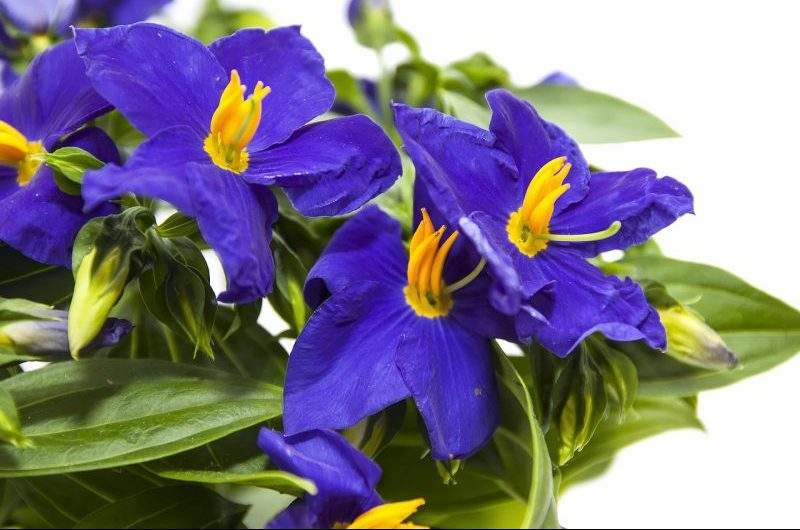Want to know how to care for campanula? Campanulas, also known as bellflower plants, are beautiful bell-shaped flowers a great addition to any garden. They come in soft-colored hues like blue, white, purple, and pink. Fortunately, it’s easy to take care of campanulas. They’re easy to grow and they’re resistant to most pests and blight.
If you’re planning to grow campanulas in your garden, here are some of the things you should remember:

Soil
Campanulas grow best in well-draining soil with a pH level of six to eight. Create a potting mix of one-part soil and one-part compost to ensure healthy plant growth and beautiful blooms for years to come.
Planting
If you want to plant them directly in the ground, be sure to space your campanulas between 15 to 18 inches apart. Plant your campanula in the ground where the crown is about an inch below the soil level. Add a layer of mulch to prevent weeds from growing and help retain additional moisture. Additionally, taller campanulas may need additional support.
For container planting, you can use loam-based compost for added drainage. You can also use water-retaining crystals to retain moisture during hot and dry weather.
Repotting
You’ll need to repot your plant once the roots start to outgrow the pot. be sure to choose a pot that’s a few inches bigger than the old one. If you don’t need to repot your plants, just make sure to replace the top layer of compost with a fresh batch every year to add more nutrients.
Watering
The best time to water campanulas is when the soil is dry to the touch. The soil shouldn’t be completely dry, but they shouldn’t be soggy either as this can promote root rot. Apply the water on the soil to prevent the leaves and flowers from getting wet. The best time to water plants is early in the morning so the sun can easily dry off any moisture that’s left on the stems and leaves.
Light
Campanulas can grow under partial shade in the afternoons, but they thrive best under full sun. The more direct sunlight they receive, the more flowers your campanulas will produce.
Temperature and Humidity
Campanulas prefer warm days and cool nights. They don’t grow well in hot or tropical climates, as well as in temperatures that go below 50 degrees F at night. If the soil is wet and the climate is humid, powdery mildew will likely develop.
Fertilizer
You can apply a balanced fertilizer once in the spring season and the other midsummer. Don’t forget to water your campanulas deeply after fertilizing. You can also apply organic compost twice a year instead of chemical fertilizers. This keeps your plants strong and well-fed without using ingredients that could harm the environment.
Mulch
Place three inches of organic mulch, like straw, compost, bark chips, etc., on the soil to keep them warm during cooler months and keep them cool during hotter months of the year. Some mulches can prevent weeds, pest infestation, and reduce the chances of soil erosion. However, make sure to keep the mulch away from the stem. As the mulch decomposes, it adds nutrients to your campanulas.
Pruning
Prune, also known as deadheading, your campanulas as the flowers begin to fade. Remove spent flowers with clean gardening shears to encourage more blooms.
Overwintering
Cut your campanulas until they’re three inches tall in late autumn. If you live in cold climates, you can add three inches of organic mulch to trap heat. For those in milder climates, you don’t need to add an overwintering mulch.
Division Propagation
Division propagation works best for campanulas with clumping varieties. Carefully dig your campanulas in the spring – about eight inches from the base. Be sure not to damage the roots! After removing the clump, you can pull them apart in sections depending on the size of your plants.
If the roots are stuck to one another, you can use a knife to pry them apart and divide them. When replanting, plant them at the same depth.
Why Plant Your Campanulas in a Hobby Greenhouse?
Have you considered planting your campanulas in a hobby greenhouse? While beautiful flowers shouldn’t be kept hidden, there are certain benefits of growing plants in a hobby greenhouse until they’re established. Here are some of them:
Keep your campanulas safe from pest infestation
Snails, aphids, and slugs are drawn to campanula plants. Check your plants for yellowing leaves and distorted plant growth as these are the most common signs of aphid infestations. You can use insecticidal soap to kill aphids. Check for slime trails and ragged holes in the leaves are some of the signs of snails and slugs. You can handpick them from your plants or better yet, grow them inside a hobby greenhouse. Placing your plants in an enclosed environment lowers the risk of pest infestation.
Protect your plants from bad weather conditions
Hobby greenhouses are also effective in keeping your plants safe from bad weather, such as frost, ice, heavy rain, high winds, and more. Keeping them inside a greenhouse ensures that they are growing in their ideal climate. Once the weather is friendly enough, you can transfer your plants outside.
Conclusion: How to Care for Campanula
Knowing how to care for campanula ensures that you’ll grow beautiful and healthy blooms throughout the year. Just remember the tips mentioned above, and you’ll be able to enjoy colorful campanula flowers in your garden.
